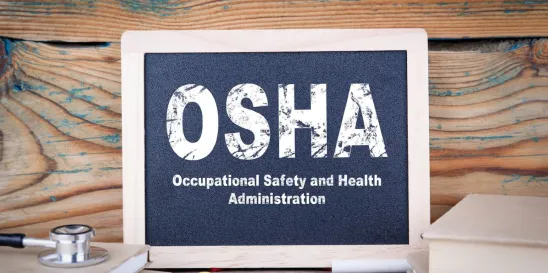This series of articles is intended to provide the reader with a very high-level overview of the Occupational Safety and Health Act (OSH Act) and the Occupational Safety and Health Administration (OSHA) and how both influence workplaces in the United States.
By the time this series is complete, the reader should be conversant in the subjects covered and have developed a deeper understanding of how the OSH Act and OSHA work. The series is not—nor can it be, of course—a comprehensive study of the OSH Act or OSHA capable of equipping the reader to address every issue that might arise.
Our first article in the series introduced the occupational safety and health framework established by the OSH Act, which applies to all private-sector employment. In this, the second article in the series, we examine the process of OSHA rulemaking.
Quick Hits
- OSHA standards set forth conditions or practices employers must adopt to ensure safe and healthy workplaces.
- OSHA regulations are designed to address other administrative purposes, such as recordkeeping requirements and inspection protocols.
- Comments do not function as “votes” for or against proposed rules, but as additional data points OSHA must consider.
Enacted in 1970 to “assure so far as possible … safe and healthful working conditions” for every person employed in the United States, the OSH Act authorized the secretary of labor to “set mandatory occupational safety and health standards” and to issue rules to meet this goal. The secretary delegated this rulemaking authority to OSHA, the agency responsible for enforcing those rules.
OSHA creates two types of rules: standards and regulations. Standards set forth the conditions or practices employers must adopt to ensure safe and healthy workplaces. Standards are the type of rules with which most employers are usually most concerned because they address safety and health hazards that must be addressed in the workplace. Regulations are designed to address other administrative purposes, such as recordkeeping requirements and inspection protocols.
Upon passage of the OSH Act, OSHA adopted multiple standards based on then-existing national consensus standards. Currently, three primary routes exist for creating or modifying an OSHA rule adoption, modification, or revocation:
- private petitions by interested persons;
- recommendations from the National Institute for Occupational Safety and Health (NIOSH); or
- recommendations from an OSHA advisory committee.
Whatever the impetus for rulemaking, once OSHA identifies a potential safety or health hazard to be addressed, or the need to amend an existing rule, OSHA decides whether to initiate the rulemaking process. The decision rests solely with OSHA, and, while it can be influenced by the president of the United States and the president’s administration, it is ultimately OSHA’s decision.
The rulemaking process involves several required steps once a need for action is identified. To initiate the process, OSHA must publish a notice of proposed rulemaking in the Federal Register. Once published, interested parties have a statutorily mandated period of at least thirty days to submit written comments. In general, OSHA will specify a comment period ranging from thirty to sixty days in the “Dates” section of the Federal Register notice, but the time can vary. For very complex rulemakings, the agency may provide a comment period lasting as long as 180 days or more. If a shorter period for comments can be justified, the comment period may be shortened, but that rarely happens.
After the comment period closes, OSHA can establish a second comment period for reply comments, but this second comment period is not required by law. The intent behind this second comment period is to allow the public an opportunity to respond to submitted comments.
OSHA must consider the comments before issuing a final rule, but the comments do not function as “votes” for or against the proposed rule; instead, they serve as additional data points that OSHA must consider. The comments and responses become part of the official rulemaking process. By statute, OSHA must publish a notice within thirty days of the closing of the comments, identifying whether any “objections have been filed and a hearing requested.” In addition to submitting written comments, interested persons also may request a hearing to challenge the proposed rule.
Finally, the OSH Act provides that within sixty days after the written notice and comment period has ended (if no hearing was requested), or within sixty days after the certification of the record (if a hearing has been held), the final rule “shall” be published in the Federal Register. The publication of the final rule must contain the date on which it is effective, which can be no sooner than thirty days after the date of publication.




 />i
/>i
